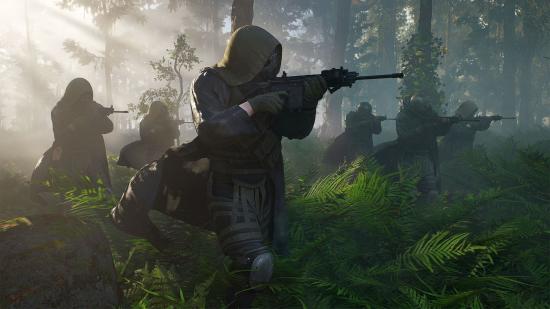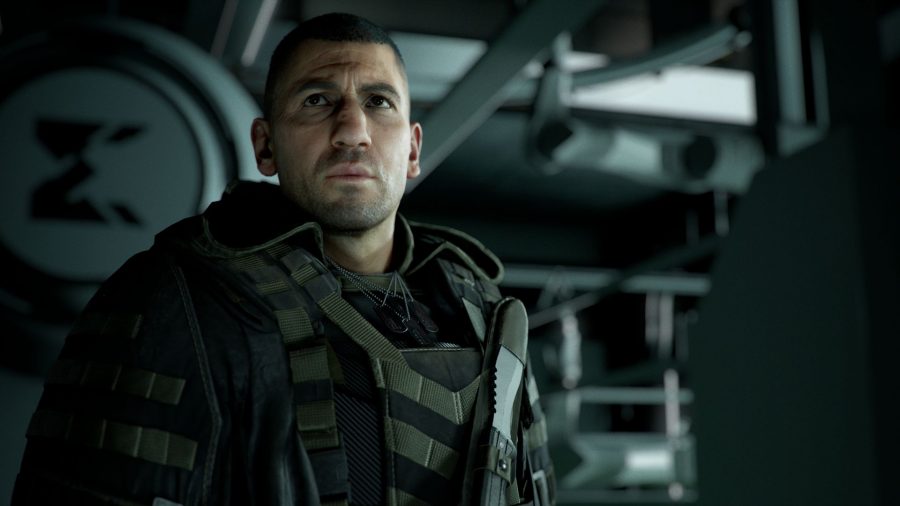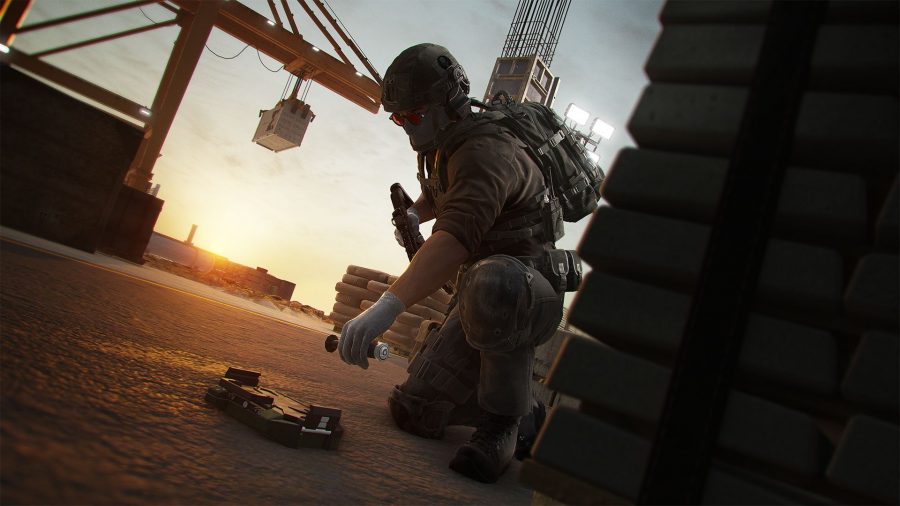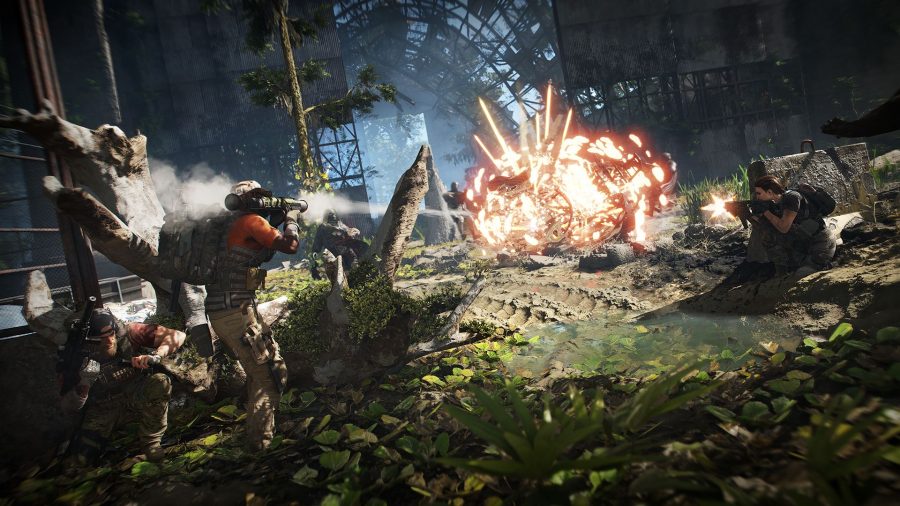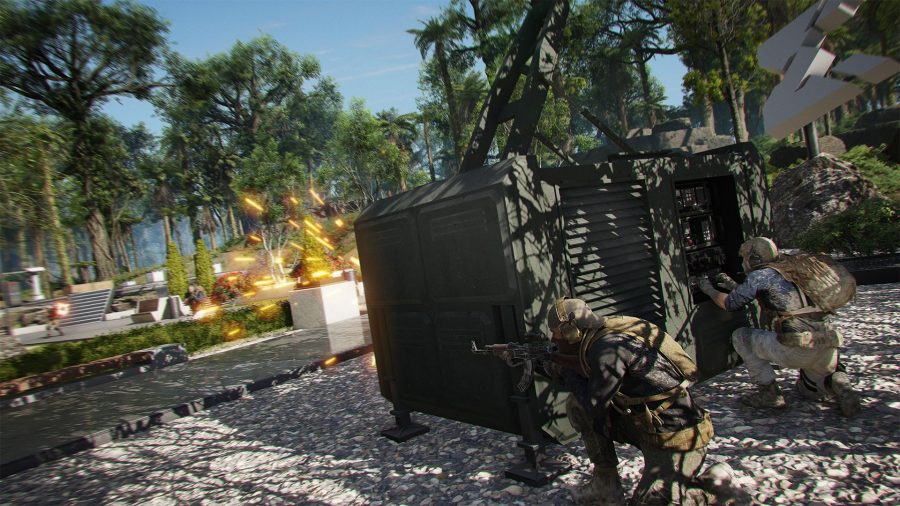Cruising along a narrow cliff-top track on a dirt bike, a mission marker on the map is fading to a distant memory. Now is the time to rendezvous with a clique of rebels at their hideout. At least, that’s what Tom Clancy’s Ghost Recon Breakpoint’s story says.
But a glimpse of a seemingly inaccessible cave entrance has proved a little too alluring. After a few moments of gently edging down the rock face, the bike touches down outside the cavern. A warm yellow light emanates from within. I enter, to find a wealth of loot stashed away in crates. For a moment, its feels a little like a Zelda game. And then the tap on the shoulder comes.
A Ubisoft rep at the Breakpoint preview event offers a friendly reminder: “The mission goal is further up the mountain.” This kind of thing will become a pattern as I play the campaign of the forthcoming entry in the Ghost Recon series. Setting off towards a mission checkpoint so often leads to spiraling distraction.
That’s nothing new. Open-world games have long offered vast 3D sandboxes that tempt the fickle among us to veer away from the job in hand. But in Breakpoint, those distracted moments feel very much part of the journey to the endgame. They even feel like they have the directed focus of linear game structures. And that is an achievement.

Breakpoint itself is a direct sequel to Ghost Recon Wildlands, and extends its predecessor’s survival aspects considerably. It also leans much more significantly into the notion that the protagonist is vulnerable, and vastly outclassed by many of the enemies on the fictional island that is the game’s setting. Beyond the delightfully fun PvE co-op mode, you play alone, with limited resources, and no help from AI squadmates. And a pack of powerful Ghosts-gone-rogue is roaming the island of Auroa, hunting you and your allies.
Breakpoint’s narrative setting has been well covered, so we’ll stick to the basics. A company named Skell Technology owns Auroa, and its work there appears to be increasingly focused on questionable military hardware. The Ghosts are sent in to investigate, but before boots hit the ground, their helicopter is downed by what looks to be a drone swarm, and survivors are scattered over the island. It’s an opening that is light on detail and heavy on tropes, but it serves its purpose elegantly. You assume the role of player-character Nomad as they pick themselves up and set off to find out what exactly might be going on across Auroa. For its opening few hours, at least, Breakpoint is a mystery yarn as much as it is a tactical shooter.
From the outset, there’s a lot going on. There’s plenty of tactical shooting to indulge in, and when you do keep your focus on the missions, they require plenty of the reconnaissance work that has underpinned this branch of the Tom Clancy gaming tree. At times, you’ll release more scout drones than bullets.
Then there’s the survival play, with light mechanics around managing health and establishing camps. There’s equally a bounty of looting and crafting to be done, and you can absolutely choose to play in myriad different styles.
Which brings us back to the notion of even the most distracted open-world play in Breakpoint feeling almost as meaningful and focused as pursuing linear mission goals. The reason? It feels like everything you do on Auroa serves to cement your playstyle, your understanding of the world around you, and the development of your character.
And then there’s the fact that your relative vulnerability instills a tone of tension and of ‘being on the edge’, regardless of what you find yourself doing in the game. Miles from the next mission point and heading away from your goal, everything you do still seems important and challenging.
“The way you value the experience you have in the game is always linked to the idea that you have the feeling you are going forward,” offers Ubisoft Paris executive producer and Ghost Recon series veteran Nouredine Abboud, as he grapples with the notion of blending linear and open-world play. “You can go forward in the story, and you can go forward with the relationship with the characters. And nowadays lots of people have the idea of developing or progressing their character. That is a very good way to create a link between all those [ways to move through the game].”
It seems he’s right. Heading off-track in Breakpoint is usually about more than simply killing time or scavenging for ammunition. There’s less of an emphasis on stealth, and a very different approach cinematographically, but its hard not to think of Metal Gear Solid V: The Phantom Pain. Breakpoint is both a place and a gameplay tone, and the distinction between on-mission and off-the-beaten track gameplay is certainly blurred.
Breakpoint is also one of the more complicated and demanding Ghost Recons, but that hasn’t stopped its team endeavouring to make it appeal to as varied an audience as possible.
“My specialty is user experience, but when we say ‘user’, it should be ‘users’ with an ‘S’,” asserts Matthew Tomkinson, UX and realisation director at Ubisoft Paris. “We have very different types of users. We have some younger players that can play a lot – they can invest more than 200 hours. […] But we also have people who might be a new father, for example, and won’t have much time. They want to make the best out of their game session when they play. We want the game to be enjoyed by both those players. The way we approach it is that we think of the different needs for the different users, and we tailor the experience for each of them.”
But if this is the Ghost Recon to push the idea of meaningful emergent gameplay like no other before it, Breakpoint takes a more conventional approach to PvP multiplayer. The 4v4 matches available at the preview event were tremendously fun and energetic, but straight down the middle as far as genre is concerned. The tactical elements such as drone reconnaissance are in place, but here Breakpoint plays more like a standard shooter. There’s nothing wrong with that, but it is the single-player – or co-op – campaign that is most distinct, relative to the confines of genre and theme.
Some will likely feel Breakpoint tries to do too much at once, at the expense of focus. But the vast team behind the game has clearly endeavoured to make this the Tom Clancy game for everyone by pushing it into new gameplay territories. And there is little wrong with an effort like that.
